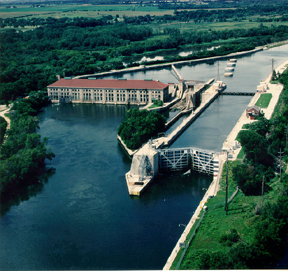Lockport Powerhouse facts for kids
Quick facts for kids |
|
|
Lockport Lock, Dam and Power House Historic District
|
|

Lockport Dam, Lock and Powerhouse
|
|
| Nearest city | Lockport Township, near Lockport, Illinois |
|---|---|
| Area | 44.2 acres (17.9 ha) |
| Built | 1910 |
| Built by | Joseph J. Duffy, Lorimer & Gallacher Co (original lock) Green & Sons co (Navigation lock) Schmidt Brothers Construction Co (control station) |
| Architect | Frederick L. Barrett (power house) |
| Engineer | Isham Randolph (original lock) Walter M. Smith (control station), Illinois state engineers (Navigation lock) M.G. Barnes, Walter M. Smith, R.S. Heath, Fred Hendershot (Lockport) |
| Architectural style | Renaissance |
| MPS | Illinois Waterway Navigation System Facilities MPS |
| NRHP reference No. | 04000167 |
| Added to NRHP | March 10, 2004 |
The Lockport Powerhouse is a special kind of dam that helps control water. It's used by the Metropolitan Water Reclamation District of Greater Chicago to manage the flow of water from the Sanitary and Ship Canal. This helps stop too much water from Lake Michigan flowing into the Des Plaines River.
Contents
History of the Lockport Powerhouse
Building the Canal and Dam
The Chicago Sanitary and Ship Canal was built to connect the Great Lakes to the Mississippi River system. This important canal reached Lockport, Illinois in the 1890s. As part of this big construction project, a lock and a dam were built in Lockport.
This project also included seven "waste gates." These gates were used to control the water level in the canal and the nearby Des Plaines River.
The Powerhouse Construction
From 1903 to 1907, the canal was made even longer, stretching from Lockport to Joliet. Building the Lockport Powerhouse started in 1905 as part of this extension.
The powerhouse was designed by an architect named Frederick L. Barrett. It has a red roof and was built in the Beaux Arts style. This means it looks grand and classic, like old European buildings. It was made from concrete blocks that were shaped to look like real stone.
How the Powerhouse Works
The powerhouse was built with four special machines called Francis-style turbines. Turbines are like big water wheels that spin when water flows through them. This spinning motion creates electricity. These original turbines could make a lot of power, about 40,000 horsepower!
Later, these original turbines were replaced with two newer ones called Kaplan turbines. The powerhouse also controls the waste gates, which help manage the water. The lock and gates were designed to handle a 40-foot drop in the canal's water level between Lockport and Joliet.
Later Changes and Recognition
More construction happened between 1922 and 1933. This was to help manage different amounts of water after another important lock, the Ohio River Standard Navigation Lock, opened.
The Lockport Powerhouse started working in 1907. Today, it is known as the oldest hydroelectric plant in Illinois. A hydroelectric plant uses water power to make electricity.
On March 10, 2004, the Lockport Lock, Dam and Power House Historic District was added to the National Register of Historic Places. This means it's recognized as an important historical site by the National Park Service.
The lock next to the dam and powerhouse is mostly used by large boats called barges. It helps barges move up or down the waterway by changing the water level by about 39 feet (11.8 meters).
This lock is the second of eight locks on the Illinois Waterway. This waterway is a very important route that connects Lake Michigan all the way to the Mississippi River.



